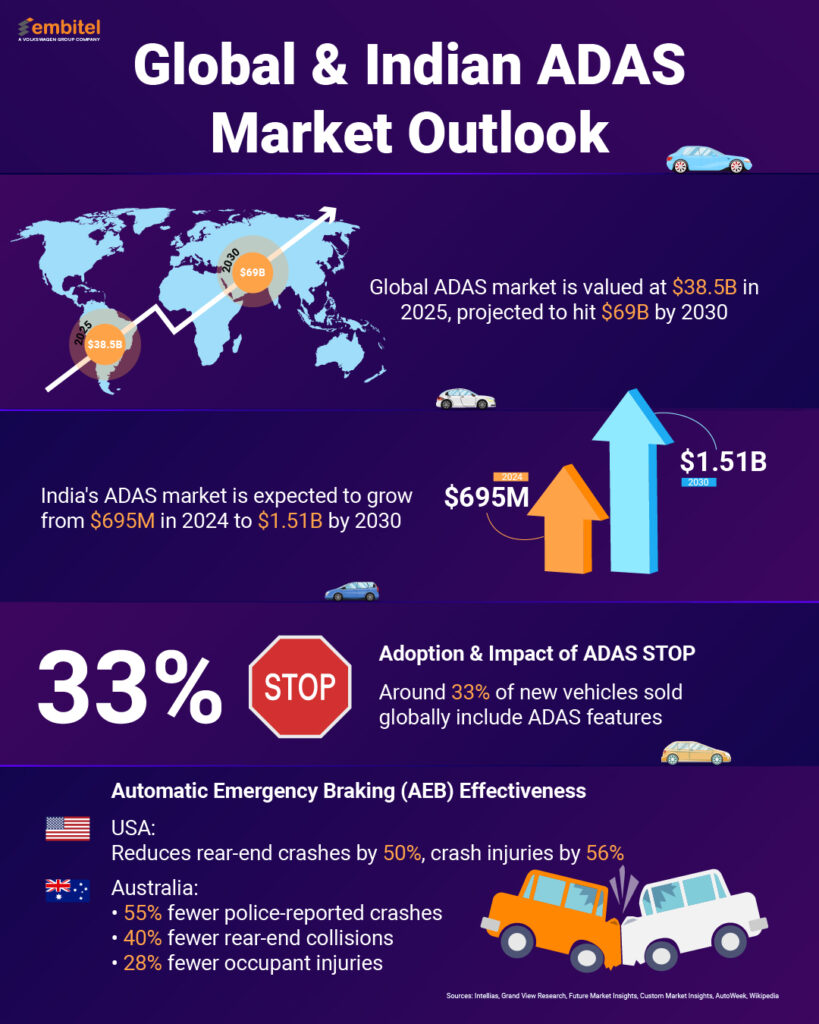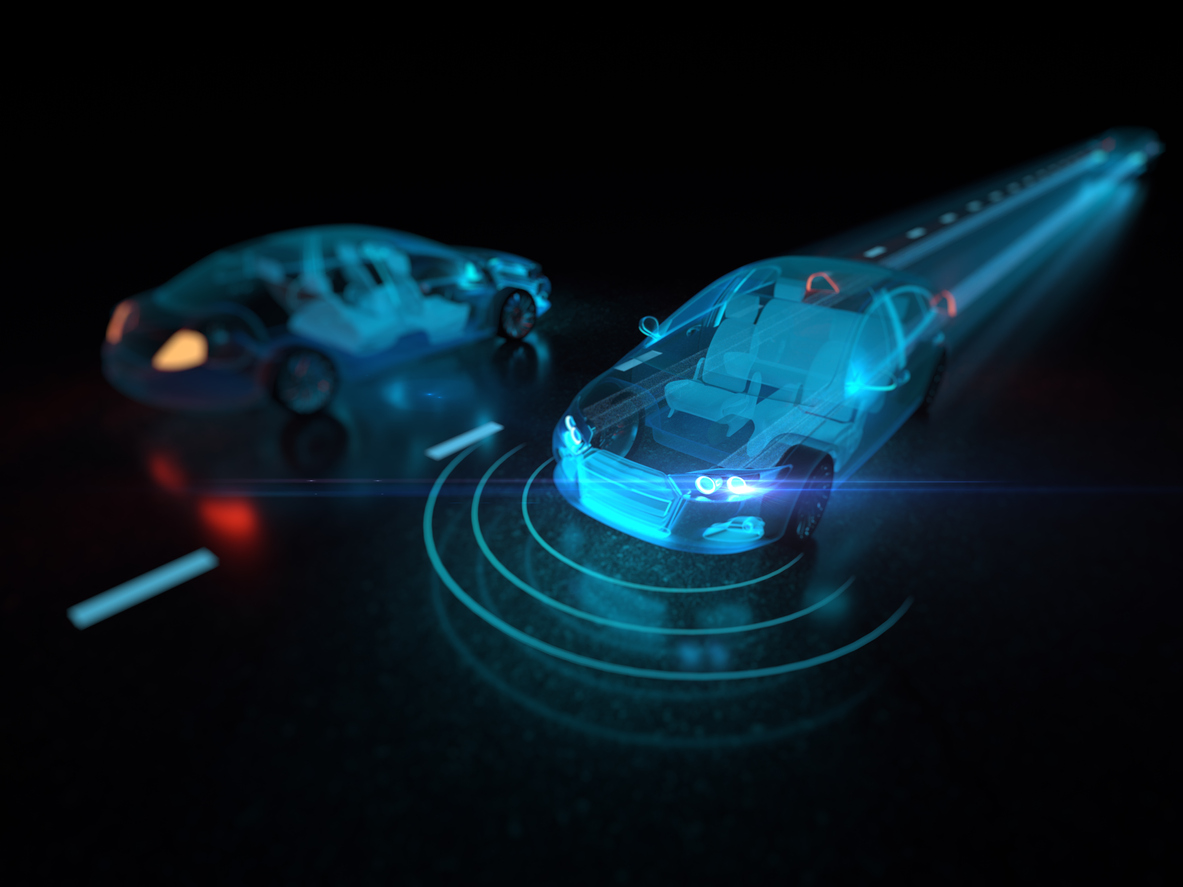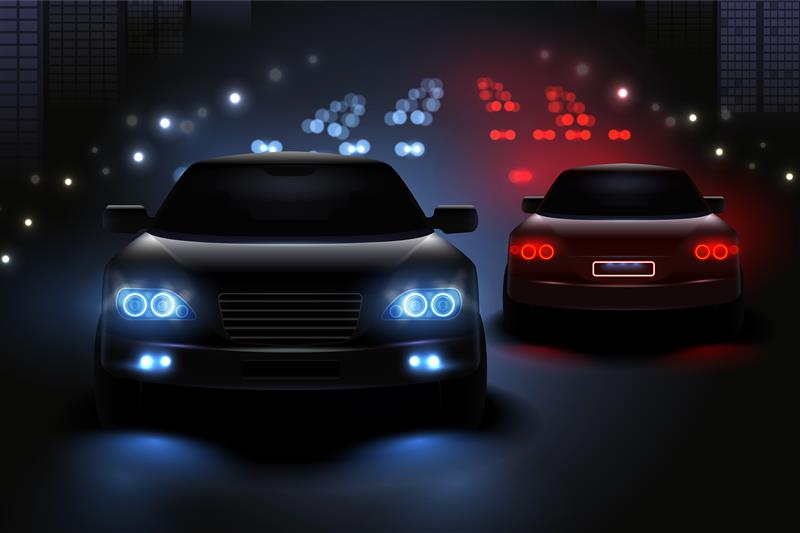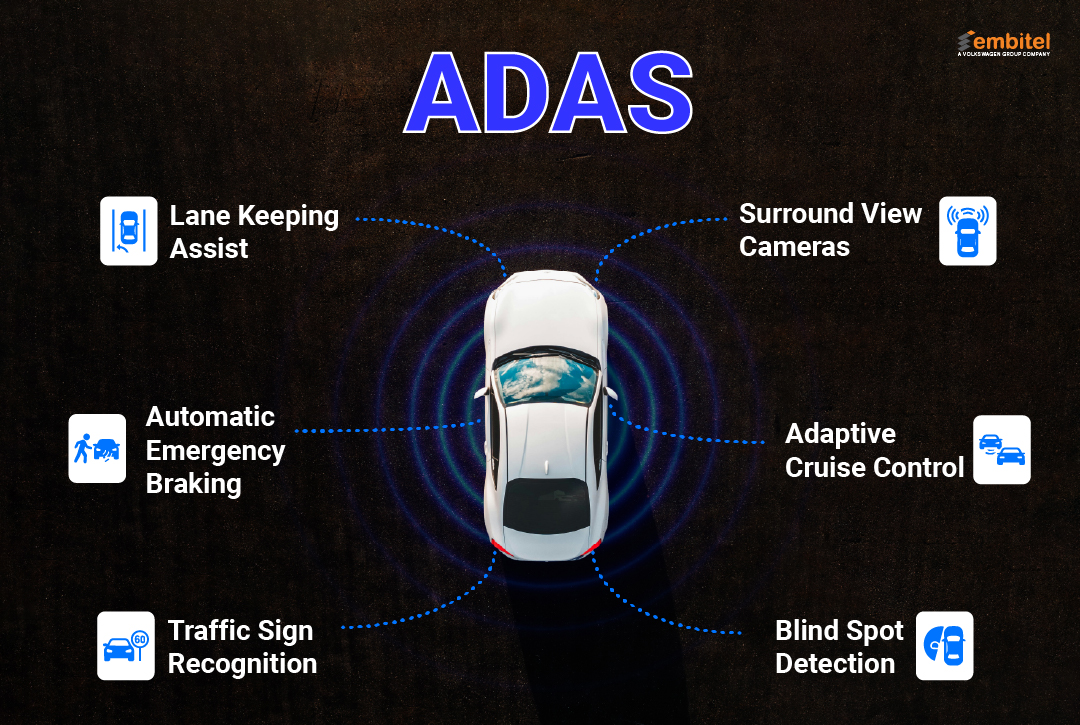
- Automotive & EV▼
- IoT▼
- Digital Solutions▼
- Industries▼
- Technology▼
- Digital Growth Enablers▼
- Commerce & Experience Services▼
- Success Stories▼
- Thought Leadership▼
- Industries
- AI/ML▼
- Company▼
- Careers▼
- Contact Us
- Blog







Advanced Driver Assistance Systems (ADAS) is a combination of intelligent hardware and software designed to assist drivers in real-time. ADAS solutions enable:
These systems use sensors such as radar, cameras, LiDAR (Light Detection & Ranging), and ultrasonic detectors to monitor the surrounding environment and provide real-time alerts or automated responses.
At Embitel Technologies, we specialise in building ADAS solutions for futuristic Software Defined Vehicles (SDVs). Our ADAS services span the entire product development cycle - from system architecture to validation and deployment.
Talk to an ADAS ExpertThe road to smarter mobility is not smooth. Roads are more congested, drivers are more distracted, and the risk of human error remains dangerously high. Adding to this are outdated vehicle systems and inconsistent traffic infrastructure, which make it clear that the margin for error is shrinking.
Even the most experienced drivers are not immune to lapses in judgment, fatigue, or unpredictable road conditions. Without the safety net of advanced systems, a momentary distraction can lead to serious consequences.
That is why driver assistance is not a “nice-to-have” feature; it’s a must-have. It helps reduce human error, improves awareness, and adds a safety net when it matters the most.
Our engineering teams go beyond just building features. We craft ADAS solutions that actively reduce risk, enhance driver awareness, and bring automation into real-world driving scenarios.
Whether it is system architecture, perception modelling, or behaviour strategy, our focus is to solve today’s mobility challenges while equipping you for what’s next in autonomous and connected driving.


We deliver scalable ADAS systems and software, ensuring seamless functionality, safety, and integration.

We provide ADAS validation services enabling you to assess the system performance under real-world conditions and simulation environments. What we do:

We ensure every component is integrated, tested, and validated for real-world deployment. We help you with:

From pilot to production, we drive results across timelines and territories. Our project management approach ensures smooth execution for complex, global automotive programs. Here’s how we do it:

We optimise radar perception models for complex environments and low-latency responses.

Our customer is a Tier-2 automotive supplier that specialises in AI-powered driver safety systems for commercial vehicles. We developed a Hardware-in-the-Loop (HIL) test automation setup using NI TestStand, LabVIEW, Python, and video-based simulations. We enabled efficient testing of various real-world driving scenarios. Adjustable settings such as eye closure time were tested, and the results were verified through logs and cloud uploads.
This automation significantly reduced manual testing time, improved test coverage, and accelerated the product’s time to market making the system more reliable and deployment ready.

We streamlined real-world driving scenario testing with adjustable settings (like eye-closure time), validated through logs and cloud uploads. instead of " . We enabled efficient testing of various real-world driving scenarios. Adjustable settings such as eye closure time were tested, and the results were verified through logs and cloud uploads.
This setup helped the customer test their system early. It saved time and cost by reducing the need for physical trials.

We are a 100% Volkswagen Group Company, engineering the connected future.
An ADAS system (Advanced Driver Assistance System) is a smart, technology-driven setup in vehicles designed to enhance safety, improve driving comfort, and reduce the risk of accidents. It acts as a co-pilot, constantly monitoring the driving environment using sensors, cameras, radar, LiDAR, and ultrasonic systems.
ADAS operational overview:
Yes, you can install ADAS in your car. However, it also depends on your vehicle's make, model, and existing electronic systems.
Aftermarket ADAS solutions are available for features like blind spot detection, parking assistance, forward collision warning, and dash cameras. These systems typically use external sensors, cameras, or radar and can be installed with minimal changes to your car’s original setup. They are a great way to improve basic safety and driving comfort without buying a new vehicle.
However, installing more advanced ADAS features such as adaptive cruise control, lane-keeping assist, or autonomous emergency braking is more complex. These systems often need deep integration with your car's steering, braking, and electronic control units. If your car was not originally built with the infrastructure for ADAS, retrofitting these features can be expensive, technically challenging, and may not have warranties if not done properly.
It is best to consult a certified technician or your vehicle manufacturer to assess what is compatible and safe. Not all aftermarket kits meet OEM standards, so choosing reliable, well-tested systems is key to ensuring both functionality and safety.
The key ADAS technologies/features include:
No. Although it is commonly seen in cars, ADAS is also used in trucks and commercial vehicles (for fleet safety), public transport buses, two-wheelers and electric vehicles, and even in agricultural and construction machinery.
The emerging technologies in ADAS are V2X, cloud-based ADAS and OTA updates.
From blind spots to smart stops, ADAS covers what humans miss. With ADAS, the conversation isn’t just about vehicles, it’s about vision, safety, and the future.
Our ADAS stack continuously analyses the driving environment to predict collisions, assess risks, and interpret complex road scenarios. By combining scene interpretation with contextual behaviour modelling, it enables proactive safety compliance and plans safe driving responses in real time, enhancing both driver comfort and road safety.